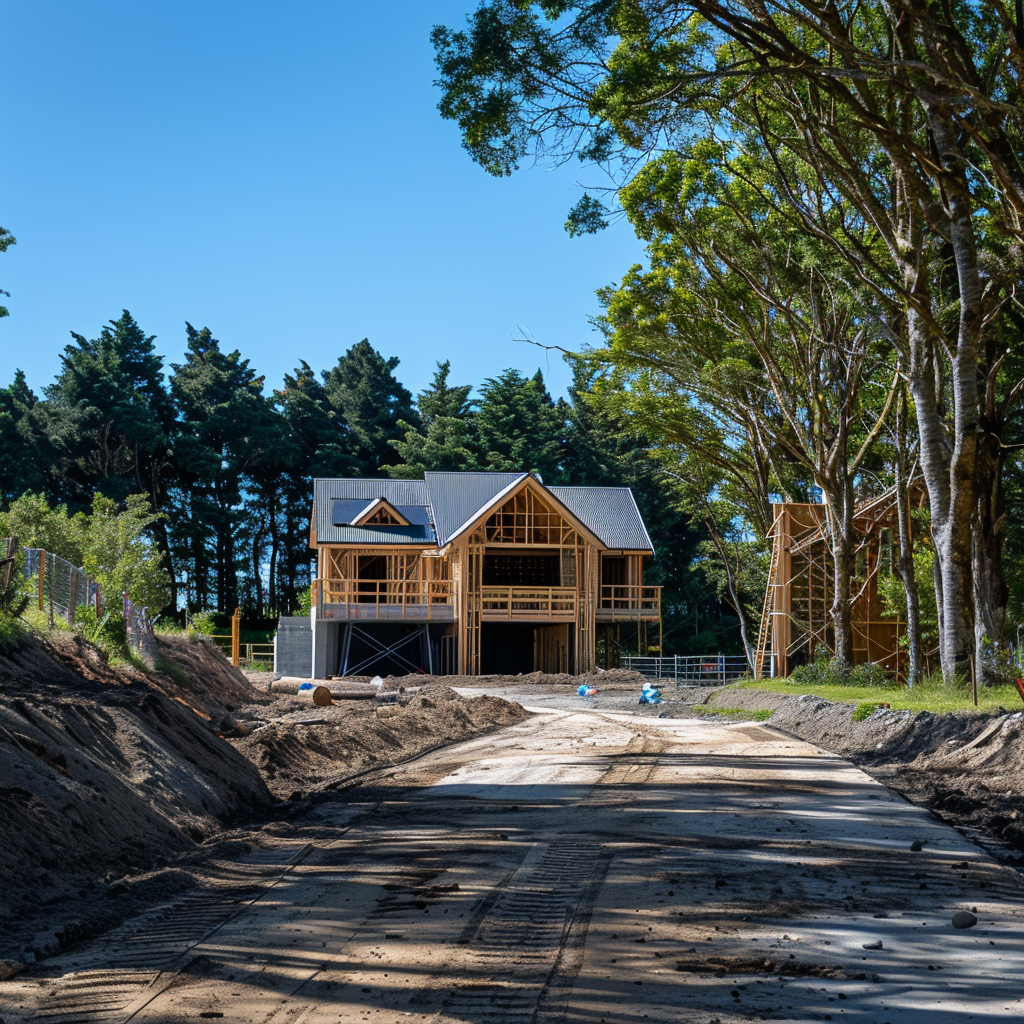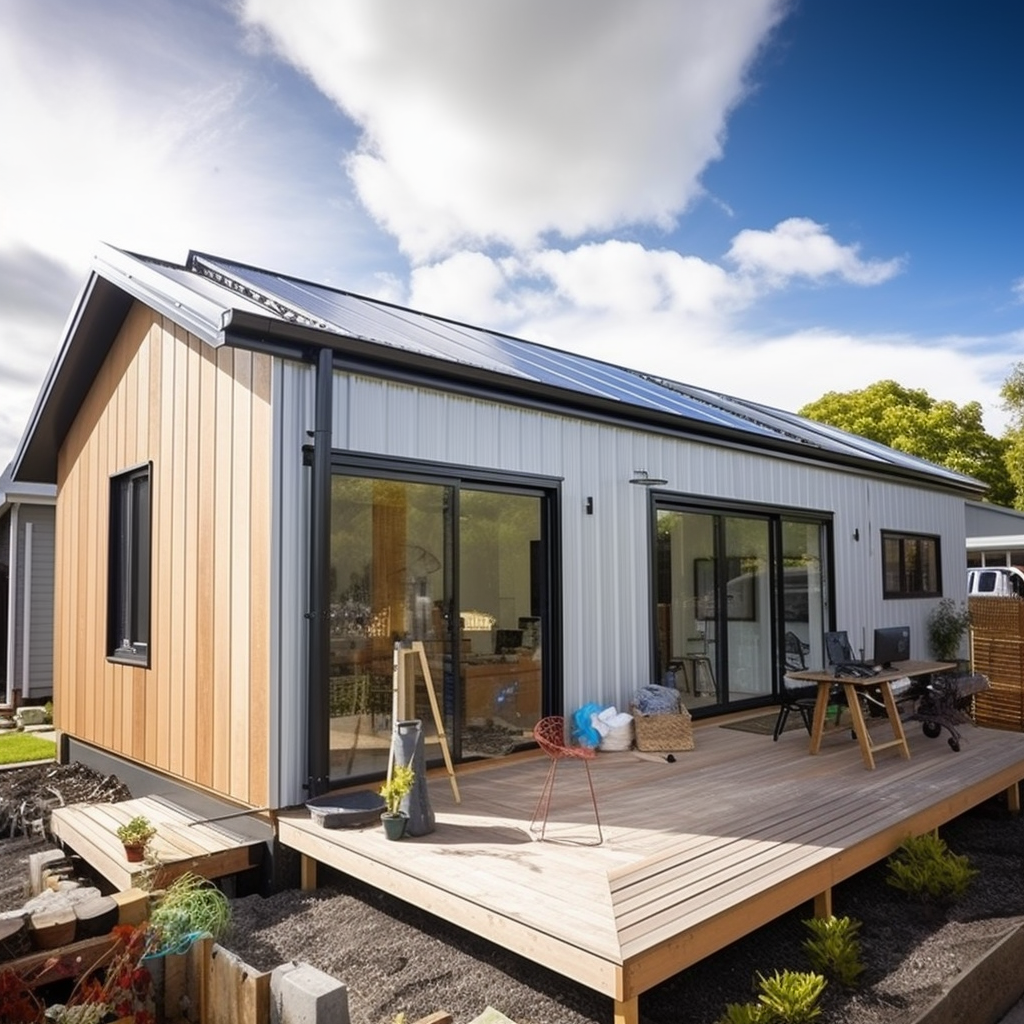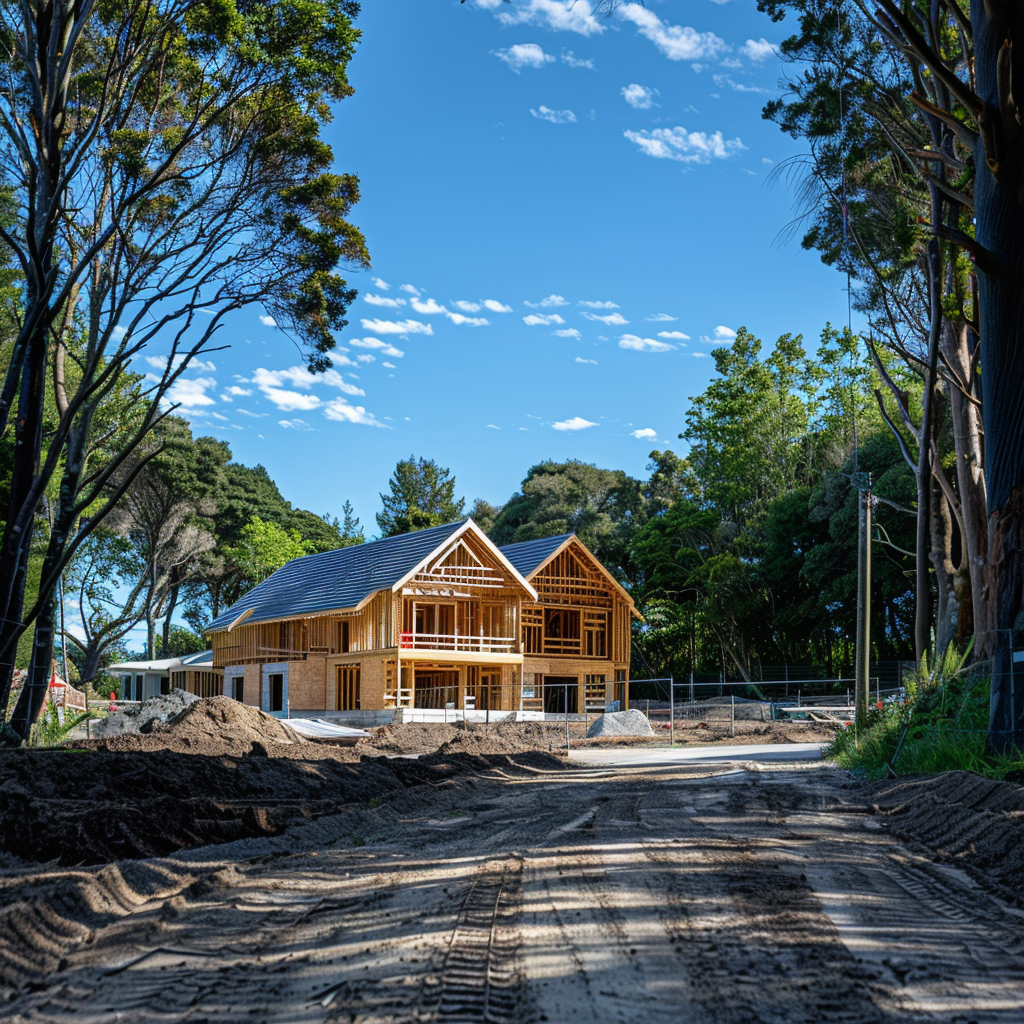When starting a construction project, we often overlook the important role of drainlayers. But these experts are crucial in making sure that constructions are solid and long-lasting. Drainlayers specialise in setting up, fixing, and maintaining the pipes that carry wastewater from buildings to treatment facilities. Their knowledge is essential for preventing water damage and keeping the structure strong.
The purpose of this article is two-fold:
- To emphasise the significant role of drainlayers in construction.
- To highlight the importance of having proper drainage systems.
Through this, we hope to create awareness about why it's important to follow all relevant rules when dealing with drainage at a construction site.
In this article, we will cover various topics related to drainlaying, including:
- The critical role drainlayers play in managing effective water flow.
- Guidelines for selecting qualified drainlayers.
- An overview of New Zealand building codes pertaining to drainage.
- Best practices for installing and testing drainage systems.
- Effective strategies for incorporating drainage considerations right from the early stages of construction.
By sharing information on these areas, our goal is to show that paying close attention to every detail is crucial when managing construction site drainage.
So whether you're an experienced property developer or someone planning their first construction project, keep reading to learn how professional drainlaying can contribute to your project's success.
1. The Vital Role of Drainlayers in Construction Projects
When it comes to construction, professionals from various fields collaborate to bring a project to life. Among these key players are drainlayers, whose tasks often go unnoticed yet hold immense significance in the construction process. Drainlayer services in NZ are integral for a construction project's success as they ensure effective water management within the site.
What Are Drainlayers?
Drainlayers are experts responsible for installing, repairing, and maintaining drainage systems in residential, commercial, or industrial projects. Their work involves laying pipes that carry waste or storm water from the building to the public sewers or other disposal points like soak holes. They also install the sewage system and related aspects such as manholes, septic tanks, and grease traps.
The Crucial Role of Drainlayers
The work carried out by drainlayers is vital to maintaining the integrity of structures. An effective drainage system prevents water accumulation that can lead to foundation weakening and structural damage over time. By managing water flow efficiently, drainlayers safeguard buildings against potential threats such as dampness, mould growth and flooding - all crucial factors in ensuring a structure's longevity.
A well-planned drainage system also contributes to public health by preventing the contamination of fresh water sources with wastewater. This highlights how important professional drainlaying services are not just for individual construction projects but also for wider community welfare.
Types of Drainage Systems in Construction
The type of drainage system installed depends on numerous factors including local climate conditions, soil type and the building's design. Here are some examples of commonly used construction drainage solutions:
- Surface Drainage Systems: These are designed to remove excess water from the ground surface quickly to prevent flooding. They involve shallow ditches known as swales and are typically used in areas with heavy rainfall.
- Subsurface Drainage Systems: Also known as French drains, these involve the use of perforated pipes buried underground to collect and redirect water away from the building. They are useful in areas with high soil saturation levels.
- Slope Drainage Systems: These aid in the diversion of water down a slope, using pipes or open channels. They are often employed in hilly areas where there's potential for rainwater to pool around the building.
- Gutter and Downspout Systems: Common in residential buildings, these involve collecting rainwater from roofs and directing it away from the structure to prevent basement flooding and soil erosion.
Each type of drainage system has its own set of complexities and requires specialist skills to install correctly. This underscores the importance of hiring certified drainlayers who can assess site conditions accurately, recommend the most suitable drainage solutions, and install them proficiently.
In essence, drainlayers perform a critical role within construction projects, contributing significantly to their long-term success. Their expertise in managing water flow effectively helps preserve building integrity while also promoting environmental sustainability and public health.
2. Ensuring Proper Drainage for Construction Success
When starting a construction project, it may be tempting to handle everything on your own, including drainage. However, this approach can lead to problems later on. That's why it's essential to hire a professional drainlayer. Here's why:
Why Hire a Professional Drainlayer?
Understanding how water flows and managing it properly requires specific knowledge and skills. Professional drainlayers are experts in handling these complexities. They make sure that the drainage system functions correctly and plays a crucial role in the overall success of your construction project.
Here are some reasons why hiring a professional drainlayer is important:
- Expertise in Drainage Systems: A qualified drainlayer knows all about different types of drainage systems and can recommend the best one for your specific project.
- Prevention of Future Problems: A professional drainlayer can predict potential issues that might arise in the future and plan accordingly. This helps prevent costly repairs or damage to the structure.
- Insurance Coverage: Most professional drainlayers have insurance coverage that protects you from liability in case of any unforeseen events or accidents during the construction process.
Selecting a Qualified Drainlayer in NZ
Choosing the right drainlayer for your job is just as crucial as deciding to hire one. Here are some practical tips to help you make an informed decision:
- Check Qualifications: Make sure that your potential drainlayer is fully qualified and certified by relevant local authorities.
- Consider Experience: Drainlayers with extensive experience are likely to provide more reliable and efficient services.
- Verify Insurance Coverage: It’s crucial that your chosen contractor has sufficient insurance coverage. This protects you from potential liabilities during the construction process.
- Ask for References: A reputable drainlayer will have a list of previous clients who can confirm their work quality and professionalism.
The Long-Term Impact of a Qualified Drainlayer's Expertise
The expertise of a qualified drainlayer goes beyond simply installing a working drainage system. Their contribution can significantly influence the long-term success and durability of a structure.
A well-executed drainage plan reduces the risk of water damage, maintains the structural integrity of the building, and ensures a safe and hygienic environment. All these factors contribute to the longevity and value of your property.
From assessing ground conditions to selecting appropriate materials and deciding on the optimal layout, the decisions made by your drainlayer shape the overall quality of your construction project.
Remember, a good drainage system is an investment in your property's future. So, when it comes to hiring a drainlayer, it's worth taking the time to find a professional who is not only qualified but also shares your vision for a successful construction project.
3. Meeting Regulatory Standards: The Role of Drainage in New Zealand Building Codes
In the world of construction, following rules and regulations is more than just paperwork. It's about making sure that the buildings we create are safe, strong, and sustainable. In New Zealand, all construction projects must adhere to the guidelines set forth in the New Zealand Building Codes (NZBC), which include specific requirements for drainage.
Understanding Drainage Requirements in NZBC
Surface Water Control (NZBC E1)
The NZBC section E1 Surface Water outlines the requirements pertaining to surface water control. It mandates that every building must be constructed in a way that sufficiently protects people and other property from adverse effects due to surface water[^1^].
Foul Water Removal (NZBC G13)
In addition, clause G13 Foul Water stipulates requirements for safe and efficient removal of foul water from buildings to an appropriate outfall[^2^]. This includes provisions for sanitary fixtures, appliances, waste pipes, vent pipes, and drains for foul water.
Why Compliance Matters
Complying with these regulations is not just beneficial but also obligatory for every construction project in New Zealand. Non-compliance can lead to severe consequences.
1. Legal Consequences
Local authorities may issue 'Notice to Fix' letters if they identify non-compliant work[^3^]. Failure to comply with such notices can result in hefty fines or even prosecution.
2. Structural Consequences
Neglecting proper drainage standards can lead to long-term structural issues. These might include dampness, flooding, soil erosion, or damage to the building foundation.
Therefore, hiring a professional drainlayer who understands these regulations plays a crucial role in ensuring regulatory compliance as well as structural integrity.
The Importance of Following NZBC Drainage Codes
Meeting regulatory standards is not merely about avoiding penalties. It's about establishing structures that are safe, resilient, and environmentally responsible. Adherence to NZBC drainage codes ensures:
- Protection of Property: Proper drainage safeguards the property from water-related damage, enhancing the longevity and resilience of structures.
- Health and Safety: Efficient removal of foul water minimises the risk of disease transmission and maintains a healthy living environment.
- Environmental Responsibility: Effective surface water control prevents soil erosion and safeguards local waterways from contamination.
In essence, the NZBC's drainage standards serve as a guideline for creating buildings that are safe, sustainable, and long-lasting. The role of drainlayers in achieving these standards is pivotal, requiring them to not just understand but also implement these regulations effectively.
4. The Integral Process of Drainage Planning in Construction
Before starting any construction work, it is essential to conduct a thorough evaluation of the site's drainage needs. This initial step is crucial for establishing an efficient drainage system that will support the durability and lifespan of the building.
Why Site Evaluation Matters
A comprehensive site evaluation helps identify and address potential water management issues before they become costly problems. It involves:
- Analyzing the Land: Understanding the natural slope and contours of the site is crucial for predicting how water will flow or collect in different areas.
- Assessing Soil Characteristics: Different types of soil absorb and drain water at varying rates. Knowing the soil composition helps in designing a drainage system that suits the specific needs of the site.
- Considering Groundwater Levels: High groundwater levels can affect where and how drainage systems can be installed. Additional measures like sump pumps may be necessary in such cases.
- Accounting for Climate and Rainfall: Being aware of seasonal variations and potential stormwater volume enables us to create a robust drainage plan capable of handling heavy rainfalls.
Designing an Effective Drainage System
Once the site evaluation is complete, the focus shifts towards designing a functional drainage system. Precision is key here, as each element must be carefully planned to ensure proper operation.
Key Factors to Consider when Designing a Drainage System:
- Capacity and Scalability: The system should not only meet current requirements but also have room for future expansion without needing major modifications.
- Integration with Other Utilities: It is important to ensure that the drainage design works well alongside existing utility systems like water supply, gas, and electricity.
- Environmental Sustainability: Minimizing negative impacts on the environment is a priority. Whenever possible, we should aim to preserve natural water cycles and reduce ecological disruption caused by drainage activities.
Examples of Drainage System Components Include:
- Pipes and Conduits: These are essential for efficiently directing water away from buildings.
- Catch Basins and Sumps: Strategically placed to collect excess water from surfaces or manage runoff in low-lying areas.
- Retention or Detention Systems: Designed to temporarily hold stormwater, easing the burden on public sewer systems during heavy rainfall.
All these components must work together seamlessly, forming an integrated system that effectively manages water and safeguards both structures and surroundings.
Ensuring Long-Term Success through Best Practices
During the design phase, it is crucial to also consider the future maintenance needs of the drainage system. This proactive approach helps ensure its long-term effectiveness:
- Easy Inspection Access: Regular checks are necessary, so the initial design should include convenient access points for inspection purposes.
- Choosing Durable Materials: Opting for high-quality materials improves longevity and reduces the frequency of maintenance requirements.
- Flexibility for Future Changes: Construction projects often undergo modifications or expansions over time. Therefore, it is beneficial to have designs that can adapt easily to such alterations.
By giving due importance to these aspects during the planning stage, we can set our construction projects up for success while minimizing potential issues related to inadequate drainage.
In summary, a detailed site evaluation followed by a well-designed drainage system serves as the foundation for resilient and sustainable construction projects. This meticulous planning reflects our commitment to excellence and foresight—qualities highly valued in New Zealand's construction industry—and ensures long-lasting functionality that withstands the test of time and nature. Moving forward, it is crucial to translate these carefully laid plans into reality by implementing precise installation practices backed by rigorous testing protocols.
5. Best Practices for Implementing Construction Drainage Systems: From Installation to Testing
Properly installing a drainage system and conducting thorough tests are crucial for the success of any construction project. This careful approach ensures effective water management, safeguarding the structure from potential damage. In this section, we will explore the step-by-step process for installing a drainage system correctly and the vital role of testing in maintaining an efficient network.
Step-by-Step Drainage System Installation
1. Site Preparation: Before laying any pipes, it's essential to prepare the site properly. This includes marking out the area, clearing access pathways, and protecting nearby structures or utilities.
2. Excavating Trenches: Precise digging of trenches is key to creating an optimal path for the pipes. The trenches should be at the right depth and slope as specified in the design plans to ensure smooth water flow.
3. Placing Pipes: Once the trenches are ready, it's time to lay down the pipes carefully. Following strict guidelines on alignment and making secure connections will help prevent future leaks or blockages.
4. Backfilling: After ensuring that the pipes are securely in place, it's important to backfill the trenches properly. Paying attention to avoid any displacement of pipes and using suitable materials with appropriate compaction methods is critical for long-term stability.
5. Connecting to Existing Systems: If there are already drainage systems in place, connecting the new ones requires expertise. It's crucial to ensure a seamless integration without disrupting the functioning of the current systems.
Common Pitfalls in Installation
Here are some mistakes that often occur during drainage system installation:
- Inadequate Slope: Not providing enough slope can lead to stagnant water, resulting in various issues such as foul odors or even structural problems.
- Improper Joint Sealing: Failing to seal joints correctly can cause leaks that undermine the entire system's effectiveness.
- Incorrect Pipe Sizing: Using pipes that are either too small or too large can lead to problems. Small pipes may get easily blocked, while oversized ones may reduce overall efficiency.
- Neglecting Soil Conditions: Different soil types have specific characteristics that should be considered during installation. Ignoring these conditions can compromise the integrity of the entire system.
The Importance of Thorough Testing
After the installation is complete, it's crucial to conduct comprehensive testing of the drainage systems. This step helps identify any potential issues early on and ensures that everything is working correctly. Two common methods of testing are:
- Hydrostatic Testing: By filling the pipes with water at a specific pressure level, it's possible to check for any leaks or weaknesses in the system.
- Inspection Cameras: Advanced camera equipment allows for visual inspection inside the pipes, making it easier to spot any irregularities or obstructions.
Ongoing Maintenance for Optimal Performance
To ensure that a drainage system continues to function effectively in the long run, regular maintenance is essential. Here are three key practices:
- Routine Cleanings: Regularly removing any debris or sediment buildup helps prevent blockages and maintains smooth water flow.
- Scheduled Inspections: Conducting periodic inspections allows for early detection of potential issues before they escalate into major problems. Keeping detailed records of these inspections also helps with traceability and future maintenance planning.
- Timely Repairs: Addressing minor repairs promptly is crucial in preventing them from turning into more significant complications that require extensive and costly fixes.
By following these best practices, construction projects can not only ensure that their newly installed drainage systems work flawlessly from day one but also maintain their performance over time. It's this attention to detail and commitment to quality that sets apart successful projects when it comes to long-term resilience against water-related challenges.
6. A Comprehensive Approach to Construction Site Drainage: What You Need to Know
Addressing drainage at the beginning of a construction project is not just smart; it's crucial for protecting building foundations and preventing future water damage. Focusing on early stage construction drainage can save both money and time, as well as ensure the long-term durability and safety of a structure.
Why Building Foundations Must Be Protected
The foundation is the most important part of any building, responsible for transferring its weight to the ground. Having proper drainage from the start helps with:
- Preventing Water Buildup: Water collecting around foundations can create pressure that weakens the structure.
- Stopping Soil Erosion: Good drainage keeps the soil around foundations stable, preventing erosion that can lead to settling and uneven support.
- Guarding Against Moisture: A dry foundation means less chance of moisture getting in and causing problems like dampness or mold inside.
Implementing strategies for building foundation drainage involves several steps, such as installing weeping tiles, applying waterproofing coatings, and making sure the ground slopes away from the foundation.
Sustainable Practices for Long-Term Water Management
Including sustainable methods in site planning and landscaping choices is crucial for effective long-term water management. Some examples are:
- Rain Gardens: These are designed areas that collect rainwater runoff from roofs, driveways, and walkways, reducing how much goes into storm sewers.
- Permeable Paving: Materials like porous concrete, paving stones, or gravel allow rainwater to soak through, replenishing groundwater while decreasing runoff.
- Green Roofs: Plant-covered roofs absorb rainfall and provide insulation, helping with both drainage and energy efficiency.
- Swales: Shallow ditches designed to redirect water away from buildings towards places where it can be absorbed naturally.
These strategies not only benefit construction but also have positive effects on the environment by reducing pollution from runoff and restoring natural water cycles.
Preventing Water Damage During Construction
A comprehensive approach to managing water on a construction site includes:
- Understanding the Site: Knowing how water naturally moves across the property can help predict potential issues.
- Considering Elevation: Adjusting the height of the building can prevent water from pooling in unwanted areas.
- Having Backup Systems: Making sure there are alternative drainage systems like extra drains or sump pumps for extreme weather situations.
By taking these steps early on, construction projects can establish a strong defense against future problems with water entering or damaging the structure.
Working with experienced drainlayers from the beginning ensures that plans for effective drainage are integrated throughout all stages of construction. The next section will explore common challenges in construction project management and how to overcome them while prioritizing comprehensive drainage solutions. This proactive approach helps keep projects on schedule while avoiding unnecessary complications due to poor water management practices.
7. Overcoming Challenges in Managing Construction Projects with a Drainage Perspective
In the world of construction project management in NZ, including a thorough drainage plan from the beginning can be crucial in avoiding delays and costly mistakes. Good drainage is vital for keeping buildings structurally sound. Project managers need to understand this and make it a part of their planning process to prevent construction delays and ensure smooth progress.
Why Drainage Matters in Construction Project Management
When drainage is integrated effectively into project management, it brings several advantages:
- Reducing Risks: Identifying potential drainage problems early on can help avoid expensive issues later.
- Sticking to Schedule: Knowing what drainage work needs to be done allows for better planning and prevents unexpected delays.
- Controlling Costs: Anticipating expenses related to drainage helps manage the budget by avoiding surprise expenses.
Dealing with Conflicts between Different Trades
Problems often arise when coordinating between different trade disciplines involved in construction. For example, an architect's vision might clash with the practical knowledge of a drainlayer. In these situations, clear communication and collaboration are essential.
Collaborative Solutions:
- Getting Input Early: Involve drainlayers during the initial planning stages to benefit from their expertise in creating a design that works well for all aspects of construction.
- Regular Communication: Schedule consistent meetings involving all trades to ensure everyone is on the same page and address any concerns promptly.
- Conflict Resolution Strategies: Develop proactive plans for resolving conflicts between trades, focusing on project goals and timelines.
By promoting an environment where teamwork is valued, project managers enable smoother workflows, reduce conflicts, and ultimately increase the chances of completing projects successfully.
The Importance of Timely Completion
Finishing projects on time is often crucial for their overall success. When proper drainage systems are designed and installed correctly, they play a significant role in keeping projects on schedule:
- Drainage systems that are done right from the start require fewer changes, which saves time.
- Planning ahead for potential weather issues ensures that drainage work can continue regardless of conditions.
In summary, effective drainage solutions are essential throughout every stage of construction project management — from initial designs to final inspections. By giving priority to these aspects early on, teams can achieve better outcomes while meeting strict timelines and budgets.
As New Zealand's building industry continues to evolve, it's crucial for professionals in all fields to stay updated on the best practices in drainage solutions. The next section will explore further how focusing on safety measures benefits both regulatory compliance and the well-being of everyone involved in drainlaying operations at construction sites.
8. Prioritising Safety in Drainlaying Work: Best Practices and Regulatory Compliance
Health and safety standards are crucial in all construction-related activities, especially in drainlaying work where there are many potential risks. Drainlayer safety practices are important not only for the well-being of workers but also for the smooth progress of construction projects.
The Importance of Health and Safety Standards
Drainlayers often work in challenging situations. They dig trenches, operate heavy machinery, handle dangerous materials, and work in tight spaces - all of which come with their own risks. It is essential to reduce these risks by strictly following health and safety standards. This includes:
- Wearing Personal Protective Equipment (PPE) at all times, such as helmets, gloves, high-visibility clothing, and safety footwear.
- Following safe work procedures like using proper lifting techniques and tools.
- Attending regular training sessions on safety protocols to reinforce the importance of safe work practices.
- Ensuring that all workers know and understand emergency response procedures.
Legal Obligations for Contractors and Drainlayers
In New Zealand, both contractors and drainlayers have legal obligations under the Health and Safety at Work Act 2015. These obligations highlight the shared responsibility of maintaining a safe work environment. Some key points include:
- Contractors must provide a safe work environment that includes necessary equipment, training, supervision, and emergency response measures.
- Drainlayers are responsible for their own health and safety while also ensuring that their actions do not harm others.
- Both parties must regularly communicate to identify hazards, assess risks, and determine appropriate control measures.
Failure to comply with these legal obligations can lead to significant fines or even imprisonment. Therefore, prioritizing safety is not just the right thing to do morally but also a legal requirement.
Implementing Safe Work Practices
Implementing safe work practices requires collaboration and commitment from both contractors and drainlayers. Here are some best practices to consider:
- Conducting regular safety audits to identify potential hazards before they become problematic.
- Creating an environment that encourages open communication about safety concerns, allowing workers to speak up without fear of retaliation.
- Including specific safety milestones in project timelines to ensure that safety remains a top priority throughout the construction process
- .
The Role of Certified Drainlayers
Certified drainlayers, with their extensive training and knowledge of industry regulations, play a vital role in upholding health and safety standards on-site. They are well-informed about safe work practices, understand the risks involved in their work, and know how to effectively reduce these risks.
By making safety a priority, fulfilling legal obligations, and implementing strong safe work practices, construction sites can become safer for everyone involved. This not only benefits the drainlayers but also contributes to a more efficient, productive, and successful construction project.
Conclusion
Drainlayers play a vital role in construction, ensuring that buildings are structurally sound and able to withstand the test of time. Their expertise goes beyond simply installing drains; it involves a comprehensive understanding of water management complexities and their impact on the built environment.
By prioritizing professional drainlaying services, construction stakeholders can:
Benefit from Expertise: Choose experienced drainlayers with the right qualifications to handle complex drainage needs.
Follow Best Practices: Adopt industry-recommended drainage methods and innovations to protect investments from potential water damage.
Stay Updated: Keep abreast of evolving practices by connecting with trade associations, attending workshops, or referring to construction and drainage regulatory websites.
For those starting new construction projects, involving a qualified drainlayer from the outset is crucial for success. It's not just about laying pipes; it's about creating a resilient drainage system that can withstand various conditions over time.
Remember, proper drainage is essential—it forms the foundation for durable structures.
Keywords for Internal Search:
drainlayer services nz, construction drainage solutions, hiring a drainlayer, why hire a drainlayer, drainlayer for construction project, effective drainage systems, preventing water damage construction, importance of proper drainage, new zealand building codes drainage, site evaluation drainage, professional drainlayer services, drainage system design, drainage system installation, testing drainage systems, construction project management nz, avoid construction delays, construction water damage prevention, early stage construction drainage, qualified drainlayer nz, nz construction regulations compliance, building foundation drainage, ensuring construction project success, health hazards stagnant water, excavation and drainage, drainlayer inspection and approval






